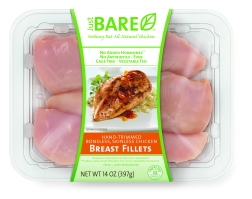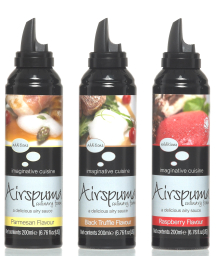P&G, Kraft settle coffee container suit
Packaging machinery demand to grow
Deadline looming for DuPont Awards entries
Chicken has nothing to hide
Foaming sauces win French award

by Pan Demetrakakes
Executive Editor
How much responsibility do packaging suppliers have for food safety?
Answering that question is a major goal of theFood Safety Alliance for Packaging(FSAP), a consortium of major food companies, suppliers, associations and other industry players. FSAP members include General Mills, Sara Lee, ConAgra Foods, Kraft Foods and other mega-users of food packaging.
FSAP’s basic strategy is to get packaging suppliers to follow the precepts of HACCP (Hazard Analysis Critical Control Points), a system of preventing safety threats by anticipating where in a process they’re most likely to occur. The impetus for FSAP’s creation last year was to eliminate mislabeling as far as possible. The idea is to get suppliers of labels and direct-print food-contact materials like cartonboard to eliminate misprints and mix-ups that result in missing allergen declarations and inaccurate ingredient listings.
FSAP initially settled on mislabeling, and still sees it as a primary target, because it’s the No. 1 reported reason for Food and Drug Administration recalls, says Wynn Wiksell, manager of packaging quality and regulatory operations at General Mills and FSAP’s chairman. The organization also is targeting other safety aspects of packaging materials, such as leaking or contaminated containers. The organization is concentrating on material suppliers for now, although Wiksell envisions working with machinery suppliers someday.
FSAP is trying to settle basic organizational issues such as what precise standards or principles should suppliers follow, and how they should prove that they did so. Winsell says FSAP does not plan to audit supplier plants, but could come up with a plan to offer audits and certification through member organizations such as the Packaging Association of Canada or the American Institute of Baking.
TOP DEVELOPMENTS
P&G, Kraft settle coffee container suitProcter & Gamble has “amicably” settled its 17-month lawsuit against Kraft Foods regarding patents for a plastic container for ground coffee. P&G, which previously manufactured Folgers products until selling the brand to J.M. Smucker in June 2008, sued Kraft in August 2007, claiming that Kraft’s 4-pound plastic Maxwell House ground coffee container infringed on P&G’s patent for a Folgers ground coffee container introduced in 2003. Although no details were provided, including the financial terms, P&G legal officer Steve Jemison said the company “was delighted with the terms of this settlement,” and Kraft general counsel Marc Firestone said the company was “pleased to settle this matter with P&G in such an efficient and pragmatic way.”
Packaging machinery demand to grow
Demand for packaging machinery worldwide is expected to rise, according toWorld Packaging Machinery Market, a new analysis fromReportlinker.com. According to the analysis, world demand is forecast to grow 5.2% annually through 2012 to $39.8 billion. Rising economic output and improved standards of living, which will result in increased consumer spending, manufacturing activity and associated packaging equipment demand, will spur product sales. Of all the packaging machinery types, labelers and coders will record the strongest gains. Demands for wrappers, bundlers and palletizers will also rise to an above-average pace. However, filling and form-fill-seal equipment will still be the most widely used type of packaging machinery, making up nearly 25% of the 2012 market total.
Deadline looming for DuPont Awards entries
The deadline for entries in the 21st DuPont Awards for Packaging Innovation is Feb. 13. Jury evaluations will focus on innovation in factors such as enhanced performance, responsible sourcing, clean production and effective recovery. “DuPont sponsors this awards program to further that progress by generating visibility for achievements not just in the packaged product but in processes and other enabling technologies that others can learn and apply in their operation,” says Shanna Moore, DuPont global business director, Sustainable Packaging. More information and entry forms can be found online atwww2.dupont.com/Packaging/en_US/awards/index.html.

NEW PACKAGES
Chicken has nothing to hidePackaging for boneless, skinless chicken breasts uses transparency to reinforce the product’s “all-natural” cachet. Just Bare chicken fillets from Gold’n Plump Poultry, St. Cloud, Minn., come in a clear plastic tray and film lidding, with a narrow paperboard sleeve that touts the product’s freedom from antibiotics and added hormones. The products are fixed-weight, allowing for uniform pricing and eliminating the need for a paper store label with weight and price. The label also includes a “Family Farm Code,” a three-digit number that consumers can enter online to learn the location of the farm that supplied the chicken.

An English marketer of gourmet foods and sauces is using aerosol technology to package sauces that foam up when they’re dispensed. Imaginative Cuisine Ltd., Reading, England, last year introduced Airspuma, a line of foaming sauces in flavors including Black Truffle, Porcini Mushroom, Mango & Passion Fruit, Raspberry, and Vanilla. The sauces and foam up at the touch of a button at the base of the dispensing spout. The packaging, trade-named NouFoam Cuisine, is fromColepCCL. Airspuma won a Trends & Innovations Award at SIAL 2008, a food industry show held in Paris.
